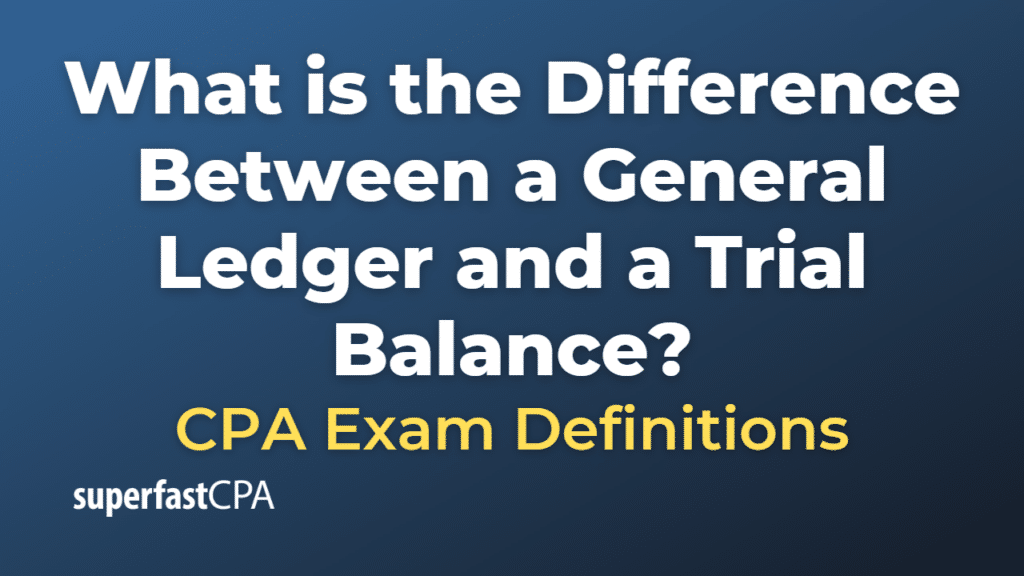Difference Between a General Ledger and a Trial Balance
The general ledger and the trial balance are two crucial components in the accounting cycle, but they serve different functions:
General Ledger
The general ledger is the primary accounting record of a company. It organizes all transactions by account, providing a record of each transaction that affects each account. Each account in the general ledger includes all the additions and subtractions (debits and credits) made to it, and its current balance.
Trial Balance
The trial balance is a report generated from the general ledger. It is prepared at the end of an accounting period (like a month or year) and lists all accounts with their final debit or credit balance. The main purpose of a trial balance is to ensure that all the debits and credits recorded in the general ledger are in balance (i.e., the total debit balances equal the total credit balances).
Key Differences
- Content: The general ledger contains individual transactions broken down by account, while the trial balance contains a list of all accounts and their final balances after all transactions have been recorded.
- Purpose: The general ledger is used to record all the transactions of a business. The trial balance is used to ensure that total debits equal total credits, helping to identify errors in the general ledger.
- Frequency: The general ledger is updated continuously as transactions occur. The trial balance, on the other hand, is typically prepared at the end of an accounting period.
In the accounting cycle, transactions are first recorded in the general journal, then posted to the general ledger, and finally summarized in the trial balance. If the trial balance is in balance (total debits equal total credits), the accountant can then proceed to prepare the financial statements. If not, the accountant must look for errors in the journal and ledger and correct them.
Example of the Difference Between a General Ledger and a Trial Balance
Let’s use a simple business example that includes three transactions and see how they affect the general ledger and the trial balance.
Transactions:
- The business starts on January 1, 2023, with $5,000 in cash from the owner’s equity.
- On January 2, 2023, the business buys equipment costing $3,000, paying in cash.
- On January 3, 2023, the business earns $2,000 in revenue but has not yet received the cash.
General Ledger Entries
Here’s how the general ledger would look after recording these transactions:
Cash (Asset) Account
| Date | Description | Debit ($) | Credit ($) | Balance ($) |
|---|---|---|---|---|
| 2023-01-01 | Owner’s equity | 5,000 | 5,000 | |
| 2023-01-02 | Equipment Purchase | 3,000 | 2,000 |
Equipment (Asset) Account
| Date | Description | Debit ($) | Credit ($) | Balance ($) |
|---|---|---|---|---|
| 2023-01-02 | Equipment Purchase | 3,000 | 3,000 |
Owner’s Equity Account
| Date | Description | Debit ($) | Credit ($) | Balance ($) |
|---|---|---|---|---|
| 2023-01-01 | Cash Investment | 5,000 | 5,000 |
Revenue Account
| Date | Description | Debit ($) | Credit ($) | Balance ($) |
|---|---|---|---|---|
| 2023-01-03 | Services Rendered | 2,000 | 2,000 |
Accounts Receivable (Asset) Account
| Date | Description | Debit ($) | Credit ($) | Balance ($) |
|---|---|---|---|---|
| 2023-01-03 | Services Rendered | 2,000 | 2,000 |
Trial Balance
Here’s how the trial balance would look at the end of January 3, 2023:
| Account | Debit ($) | Credit ($) |
|---|---|---|
| Cash | 2,000 | |
| Equipment | 3,000 | |
| Accounts Receivable | 2,000 | |
| Owner’s Equity | 5,000 | |
| Revenue | 2,000 | |
| Totals | 7,000 | 7,000 |
As you can see, the total debits equal the total credits on the trial balance, which means our general ledger is in balance. This trial balance now provides a clear overview of the ending balances in each account, which would be used to prepare the financial statements.












